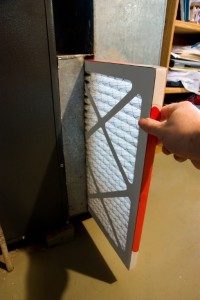 Installing high-efficiency heating and cooling equipment will save you money and reduce your home’s greenhouse gas emissions. If everyone had an energy-efficient furnace, the country as a whole would save about $171 million per year, and we would see a reduction of greenhouse gas emissions equivalent to taking 177,000 cars off of the road.
Installing high-efficiency heating and cooling equipment will save you money and reduce your home’s greenhouse gas emissions. If everyone had an energy-efficient furnace, the country as a whole would save about $171 million per year, and we would see a reduction of greenhouse gas emissions equivalent to taking 177,000 cars off of the road.
While impressive, those numbers are for brand-new heating and cooling systems. In order to keep them working as efficiently as possible, your furnace and air conditioner need to be maintained properly.
To keep the equipment running efficiently, have a professional perform maintenance on the systems in the spring and fall before each peak season begins. It is best to take a two-prong approach to HVAC maintenance: a bi-annual tune up by a professional, and smaller, ongoing tasks you can do yourself throughout the year.
Professional Maintenance
Depending on the type of HVAC system you have, a typical professional maintenance call will involve tightening electrical connections, checking the condition of all hoses and belts, lubricating all moving parts and making sure the controls work properly. The technician will also measure the pressure in the system and check for leaks where appropriate, including leaks in the venting system.
For cooling components, the technician will clean the evaporator and condenser coils. He or she will also check the fan mechanisms and make sure the refrigerant level in the system is correct.
For heating systems, technicians check fuel connections, change the required filters and inspect the combustion and heat exchangers. They also check for possible leaks, and if you have a boiler, make sure the low-water cutoff and pressure relief valves are working properly.
DIY Maintenance
Here are a few maintenance tasks you can perform yourself between professional visits:
- Change the filters on forced-air systems about every three months for a system that includes both heating and cooling. If the systems are separate, change the filters every three months during the heating or cooling season. The type of filter to use and directions for changing it can be found in the manual that came with the system. If you don’t have one, ask an HVAC contractor for advice, or visit the manufacturer’s website to see if manuals are available.
- Check around the house to make sure that heating and cooling vents, baseboard heaters and radiators are not blocked by furniture. Blocked vents mean the system has to work harder to provide you with the comfort you want, placing unnecessary strain on the system. It is also a good idea to vacuum the face of the vents to remove dust and other debris.
- Central air conditioning systems have an outdoor component that houses the compressor and condenser. This part of the system dumps the hot air from your house to the outside as part of the cooling cycle. Keep leaves and other debris off of the top of the unit, and clear a 2- to 3-foot space around the unit to help it work properly.
Even if you’ve recently installed a new unit, begin a maintenance program right away. Regular maintenance is the key to keeping heating and cooling equipment operating efficiently. Help save the earth (and save yourself some money) by making sure all of your systems are properly maintained.
Home-improvement author Fran Donegan writes about heating and cooling systems for The Home Depot.